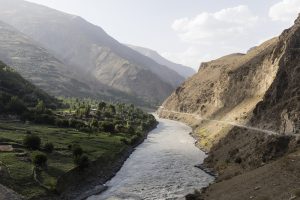After the takeover of Afghanistan by the Taliban on August 15, the country once again became the epicenter of a new refugee crisis that sparked worry in regional neighbors and farther abroad. Afghanistan’s Central Asian neighbors from the outset made clear that they will not welcome large numbers of Afghan refugees. Those who have crossed into these countries have either been returned or quickly sent onward to a third country.
Tajikistan is an outlier with its openly anti-Taliban rhetoric, as evidenced by President Emomali Rahmon’s open disdain at the developments in Afghanistan. Nevertheless, as much as Dushanbe has said it is willing to shelter Afghans crossing the border, Tajik officials have had to moderate their enthusiasm for accepting an influx of refugees because Tajikistan’s neighbors and Russia have expressed grave concerns over the potential arrival of migrants to the region.
The basic principles of “humanism and good neighborliness” guided the State Border Troops of Tajikistan to allow a first flood of people onto the territory of Tajikistan at the beginning of the last stage of the conflict in Afghanistan (see the border incidents on June 21 and July 3). Around the same time of those crossings, Tajikistan’s Gorno-Badakhshan district announced that it would be ready to accept up to 10,000 refugees. On July 23, deputy chair of the Committee on the Emergency Situations of Tajikistan stated that the country had the capacity to accept 100,000 refugees.
Tajikistan’s Central Asian neighbors, on the other hand, strongly oppose any flow of refugees and view them primarily as a security concern. In addition to other concerns, fears regarding the flow of refugees pushed Turkmenistan and Uzbekistan to start negotiating with Taliban years ago. In 2020, a Turkmen delegation held negotiations with the Taliban to guarantee the blocking of possible flows of refugees to its territory. In July 2021, Turkmenistan held another dialogue with the Taliban to receive guarantees of protection for their mutual border.
Uzbekistan similarly entered into negotiations with the Taliban a few years ago, in part to receive assurances of maintaining security at the border. Tashkent has condemned each attempt to cross its border by Afghans, and the Ministry of Foreign Affairs of Uzbekistan described refugee inflows as a violation of national borders and pledged that the perpetrators would be “severely punished.” Uzbekistan defends its decision to not admit refugees by prioritizing work on preventing a humanitarian crisis in Afghanistan, for example by leaving its railroad to Mazar-i-Sharif open for the delivery of humanitarian aid.
Kazakh President Kassym-Jomart Tokayev said that he supported the common position of the Collective Security Treaty Organization (CSTO) on non-admission of Afghan refugees to their territories. Kyrgyz President Sadyr Japarov proposed to go as far as creating a security belt in the region, developing a strategy to prevent encroachment at the Shanghai Cooperation Organization (SCO), and controlling migration processes.
Russia’s opinion on the matter, as a significant player in the region, has weight on what choices the Central Asian countries make. Moscow has clearly come out against any refugee flows to Central Asia. President Vladimir Putin spoke against even temporarily placing Afghan nationals in Central Asia for processing to receive visas to the U.S. and Europe. The ambassador of Russia to Uzbekistan said that refugee admittance would be akin to opening the flood gates and allowing for uncontrolled migration from Afghanistan, implying further that reaching Russia from Central Asia would therefore become easier.
Tajikistan is surrounded by neighbors that strongly oppose sheltering anybody from Afghanistan and Russia’s similar opposition adds further pressure on Dushanbe to reconsider its earlier position. As a member of the CSTO, Tajikistan also has motivation to heed member opinions that are overwhelmingly anti-refugee as well. Dushanbe, therefore, had little choice but to moderate its rhetoric. Furthermore, on September 2, Tajikistan’s Minister of Interior Affairs Ramazon Rahimzoda said that his country will not accept a large number of migrants from Afghanistan due to the lack of infrastructure for accommodation and the financial burden on Tajikistan.
Tajikistan earlier seemed to want to welcome Afghan refugees, with various government officials expressing support for accepting from 10,000 to 100,000 migrants. But over the past two months, as the situation in Afghanistan eroded more quickly than most predicted, that plan seems to have been scrapped in response to the nervousness of neighboring countries that view refugees as a security threat, rather than a humanitarian obligation.































